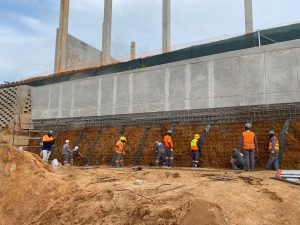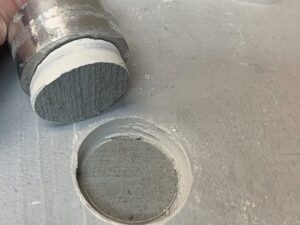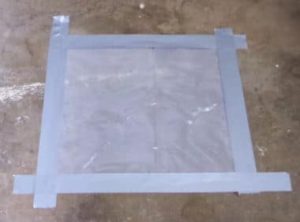By Carl White
Colloidal silica post-placement pozzolan technology is often used as a superior curing medium. Testing has shown that SCP treatments are comparable to or better than 28-day moist cured samples. SCP is a one-time application that can be used on any uncoated architectural or structural concrete. These include new or existing concrete slabs, walls, structural elements and overhead applications.
Colloidal silica extends hydration
Colloidal silica post-placement pozzolan extends the hydration process. SCP technologies are applied at the end of the third stage of the hydration process. This stage is largely associated with the hydration of tri-calcium silicate. As more calcium hydroxide (CH) and calcium silicate hydrates (C-S-H) precipitate out of the pore solution and grow in size, the hydration rate increases. Precipitation relieves the supersaturation of the pore solution and enables dissolution of the cement mineral to continue. During this continuous process, cement minerals are replaced by new hydration products. The pore solution acts as a necessary transition zone between the two solid states. By the end of this phase of hydration, 30% of the initial cement has hydrated and the paste has undergone initial and final set.
Colloidal silica enters the concrete
After reaching final set, colloidal silica enters the concrete through capillary pores previously occupied by water. Between 50% and 60% of the completely hydrated paste consists of C-S-H and 15% to 25% methyl. The colloidal silica in SCP technology reacts with excess CH to create more C-S-H in the concrete. This is the main hydration product responsible for concrete strength. The accessible capillaries and pores are permanently filled, sealing the concrete and locking in the remaining moisture. By maintaining moisture in the concrete, the hydration process is extended as long as temperature is controlled.
Temperature-dependent cement hydration
Concrete gains the majority of its properties during the temperature-dependent cement hydration reaction. Temperature of the concrete and surrounding environment can impact the quality of the final concrete product.
In South Africa, large volumes of concrete are placed in temperatures of 26°C and higher. In these temperatures, evaporation rates exceed 1kg/m2/h, resulting in the faster loss of moisture in freshly mixed concrete.
As temperature increases, workability and set time of concrete decreases. Warm temperatures also lead to high early compressive strength that is followed by lower long-term compressive strength gains. Moreover, rapid evaporation of bleed water results in plastic shrinkage cracking in concrete.
Sound planning is, therefore, required when placing concrete in hot weather. This is to reduce and control temperatures and evaporation rates. Measures to control temperatures can consist of, among others, preplacement conferences and the use of admixture and evaporation products. Adjusting concrete mix proportions is also an acceptable method. Wind and relative humidity, as well as ambient and concrete temperature are the most important factors when considering evaporation rate.
This nomograph has been used throughout the industry for decades and still prevails as the most widely used tool for calculating evaporation rates.
Mitigating risks
There are many different ways to mitigate risks associated with hot weather concreting at the ready-mix plant and on site. Acceptable methods of reducing temperature during concrete production include shading aggregate stockpiles and sprinkling water on coarse aggregate stockpiles. Chilled water can also be used for concrete production. This is in addition to substituting chipped or shaved iced portions of the mixing water and cooling concrete materials with liquid nitrogen. Measures used on the job site include timely placement and finishing; control of bleed-water evaporation; curing; and protection. Ways of reducing evaporation rates on site include erecting wind and sunshades. This is in addition to the use of evaporation retarders and appropriate curing methods.
Concrete-strength specimens
The initial curing of concrete strength specimens is often overlooked in hot weather. This is because they are small quantities of concrete compared to actual cast-in-place elements. As a result, cylinders and beams are more severely affected when concreting in high temperatures. ASTM C31 Casting of Concrete Strength Specimens in the Field requires that strength samples be stored at temperatures of between 15°C and 26°C for normal strength concrete. Meanwhile, concrete with a specified compressive strength of 41MPa and higher needs to be stored at temperatures of between 20°C and 25°C. Furthermore, the specimens should be shielded from direct sunlight and protected from moisture loss.
Another important consideration is thermal shrinkage of the concrete structure due to a rapid decline in concrete temperature of 22°C in the first 24 hours. Thermal shrinkage can be reduced by using chilled concrete; cool pipes in the concrete structure; and supplemental cementitious materials. This is in addition to the use of mist water; curing methods; or by shading the slab.
Colloidal silica post-placement pozzolan
Spraylock Africa is the African agent for Spraylock Concrete Protection’s cutting-edge colloidal silica post-placement pozzolan technology.
We continue to stand by SCP solutions. Our unique technology has a more than 35-year-long track record in the market. It is supported in the field by a team of experienced and skilled people who are passionate about and dedicated to solving our clients’ unique concrete challenges.






